April 28, 2023
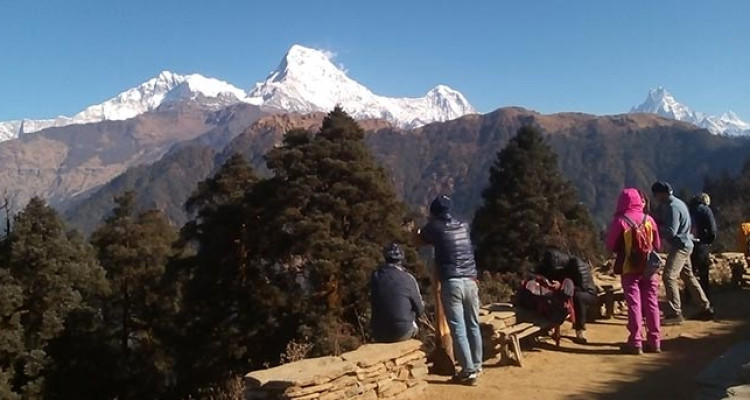
Poon Hill trek is a popular hiking route located in the Annapurna region of Nepal. The trek is named after the famous Poon Hill viewpoint, which is situated at an altitude of 3,210 meters and offers stunning panoramic views of the Himalayan range, including Annapurna and Dhaulagiri.
The trek begins from the town of Nayapul, which is about an hour’s drive from the lakeside city of Pokhara. From Nayapul, the trail follows the Modi Khola river and passes through small villages, lush forests, terraced farmland, and scenic river valleys, offering an opportunity to experience the natural beauty and cultural richness of the region.
The trek route passes through several villages such as Tikhedhunga, Ghorepani, and Tadapani before reaching the famous Poon Hill viewpoint. Along the way, trekkers can witness the local culture and lifestyle of the Gurung and Magar communities, who are the indigenous people of the region.
The Poon Hill trek route is well-marked and relatively easy to navigate, making it a popular choice for novice hikers and those with limited time for trekking. The entire trek usually takes about 5-7 days, depending on the itinerary chosen.
The best time to trek to Poon Hill is during the spring and autumn seasons, which fall between the months of March to May and September to November respectively.
During the spring season, the weather is generally clear with mild temperatures, making it an ideal time for trekking. The flowers and rhododendron blooms are also in full bloom during this season, adding an extra charm to the trek. However, it can get a bit crowded on the trail due to the peak trekking season.
The autumn season, which starts from September, offers clear skies, excellent views of the mountain ranges, and stable weather conditions. The temperatures are also relatively mild, making it comfortable for trekking. This season is a popular time to trek, so the trail can also be busy.
The monsoon season, from June to August, brings heavy rainfall, landslides, and leeches on the trail, making trekking challenging and unsafe. Similarly, during the winter months of December to February, the temperature can drop below freezing, making the trail icy and difficult to trek. Hence, it is advisable to avoid trekking during these seasons.
In summary, the best time to trek to Poon Hill is during the spring and autumn seasons, when the weather is clear and stable, and the temperature is mild, making it comfortable for trekking.
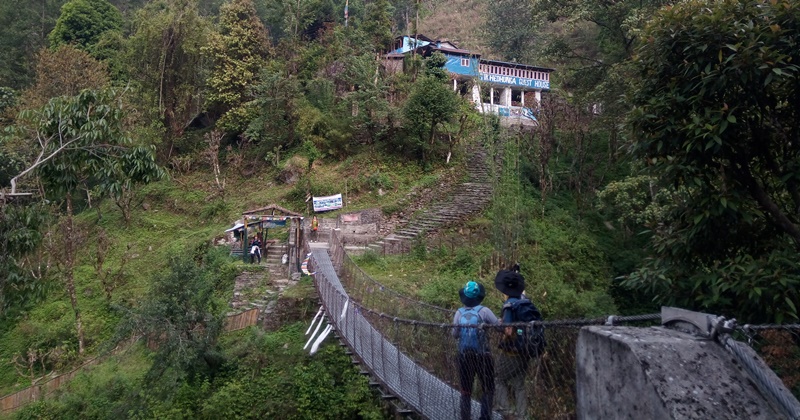
Crossing Suspension bridge after Thikhedunga
Difficulty level of Poon Hill trek
The Poon Hill trek is considered a moderate trek, suitable for hikers of all ages and fitness levels. The trek involves a few steep uphill climbs and descents, but the trail is well-maintained and relatively easy to navigate. The highest point of the trek is Poon Hill, which stands at an altitude of 3,210 meters, and requires a bit of effort to climb, but the breathtaking views from the top are worth it. While prior trekking experience is not required, it is recommended to have a basic level of fitness and stamina to complete the trek comfortably. Overall, the Poon Hill trek is a manageable and rewarding trekking experience for most people.
When packing for the Poon Hill trek, it is essential to pack light and carry only the necessary items. Some essential items to pack for the trek include comfortable and sturdy trekking shoes, warm and waterproof clothing, a backpack, water bottles, a first-aid kit, sunscreen, sunglasses, a hat, and a sleeping bag. It is also advisable to carry some snacks and energy bars to keep up energy levels during the trek. Trekking poles can also be helpful to ease the strain on knees during the steep climbs and descents. It is important to note that over-packing can make the trek more challenging, so packing light is key.
There are several accommodation options available along the Poon Hill trek route. The trek passes through many small villages, and each village has several teahouses or lodges that offer comfortable accommodation and basic amenities. The teahouses are usually family-run and provide private or shared rooms with simple bedding and attached or common bathrooms. Some teahouses also have a common dining area that serves a variety of local and international food. The cost of accommodation and meals at the teahouses is reasonable, and most teahouses also provide hot showers and Wi-Fi for a small fee. It is recommended to book the accommodation in advance, especially during the peak trekking season, to avoid disappointment.
During the Poon Hill trek, trekkers can indulge in a variety of local cuisine and food options. The teahouses and lodges along the trek route offer a wide range of food, including Nepali, Indian, Tibetan, and Continental dishes. Some popular Nepali dishes that trekkers can try include dal bhat (rice, lentil soup, and vegetables), momos (dumplings), thukpa (noodle soup), and chow mein (stir-fried noodles). The teahouses also serve tea and coffee, and local drinks such as rakshi (local alcohol made from millet or rice). Trekkers can also find snacks such as biscuits, energy bars, and chocolate bars to keep their energy levels up during the trek.
The Poon Hill trek offers a unique opportunity to experience the rich cultural heritage of the Nepalese people. The trail passes through several traditional villages inhabited by Gurung and Magar communities, known for their warm hospitality and unique cultural practices. Trekkers can witness traditional dances, music performances, and partake in local cuisine, such as dal bhat, a popular Nepalese dish. The trek also includes a visit to the Ghandruk Museum, which showcases the local culture and history. Additionally, the trek offers stunning views of the Annapurna and Dhaulagiri mountain ranges, which are revered as sacred by the locals and hold significant cultural significance.
Poon Hill is famous for its stunning sunrise and sunset views over the Himalayas, which attract thousands of trekkers every year. To witness the sunrise, trekkers start hiking in the early morning hours, usually around 4 am, from Ghorepani village. The trail takes about an hour to reach the summit of Poon Hill, which is at an altitude of 3,210 meters. As the sun rises, it paints the surrounding peaks with shades of pink, orange, and gold, creating a breathtaking panorama. Similarly, the sunset views from Poon Hill are equally awe-inspiring, with the setting sun casting a warm glow over the snow-capped peaks. These magical moments are a must-see for any visitor to the Poon Hill region.
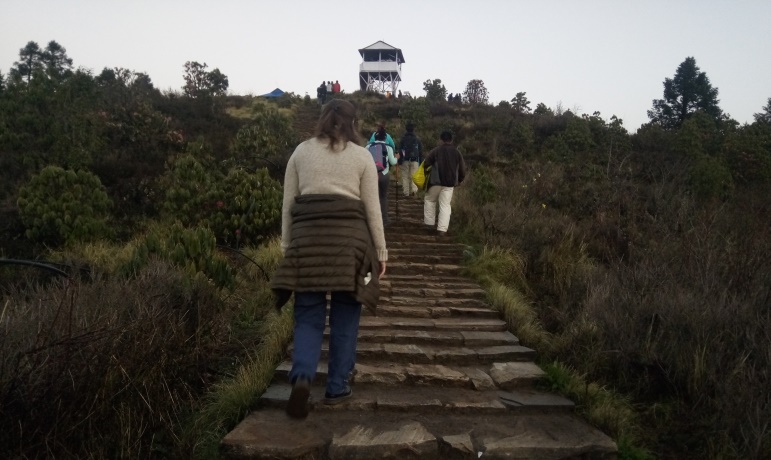
The Poon Hill trek is a paradise for photography enthusiasts, offering spectacular views of the Himalayas and the surrounding landscapes. Here are some of the best photography spots on the Poon Hill trek:
These are just a few examples of the many photography spots that the Poon Hill trek has to offer.
The cost of the Poon Hill trek can vary depending on several factors, such as the duration of the trek, the type of accommodation chosen, the number of meals provided, and the mode of transportation used. Here is a rough cost breakdown of the Poon Hill trek:
Overall, the total cost of the Poon Hill trek can range from USD 300 to USD 600 per person, depending on the above factors and personal preferences.
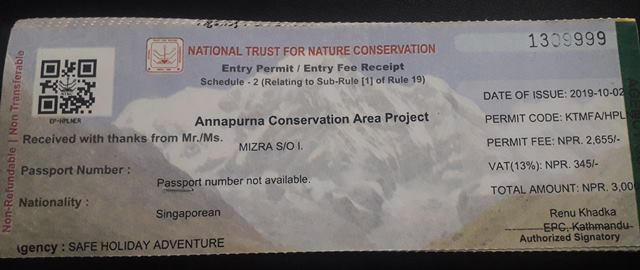
To trek in Poon Hill, you need two permits: TIMS (Trekkers Information Management System) and Annapurna Conservation Area Permit (ACAP). TIMS costs NPR 1,000 for individual trekkers and NPR 2,000 for group trekkers. ACAP costs NPR 3,000 for foreign nationals and NPR 100 for SAARC nationals. You also need to carry a valid ID proof and two passport-sized photographs. Physical fitness is essential for trekking in Poon Hill, as the trek involves steep ascents and descents. Adequate preparations, including training and conditioning, are necessary. Proper gear and clothing, such as a good pair of trekking shoes, warm clothes, and rain gear, are also essential.
Trekking in Poon Hill can be a safe and enjoyable experience if you take necessary precautions. Here are some safety tips to keep in mind:
There are several trekking itineraries for Poon Hill, ranging from short and easy to long and challenging. Here are some popular options:
Poon Hill Trek (3-5 days): This is a short and relatively easy trek that takes you through beautiful villages and rhododendron forests to Poon Hill, from where you can enjoy panoramic views of the Annapurna and Dhaulagiri mountain ranges.
Ghorepani Poon Hill Trek (5-7 days): This trek takes you through quaint villages, dense forests, and alpine meadows to reach Poon Hill. You will also visit the village of Ghandruk and pass through terraced fields and bamboo forests.
Annapurna Base Camp Trek (7-12 days): This trek takes you to the base of the majestic Annapurna massif, through lush forests, cascading waterfalls, and traditional villages. You will also visit Machhapuchhre Base Camp and enjoy stunning views of the Annapurna range.
Annapurna Circuit Trek (14-21 days): This is a long and challenging trek that takes you through diverse landscapes, from subtropical forests to high-altitude desert. You will cross Thorong La Pass, the highest point of the trek at 5,416m, and enjoy stunning views of the Annapurna and Dhaulagiri ranges.
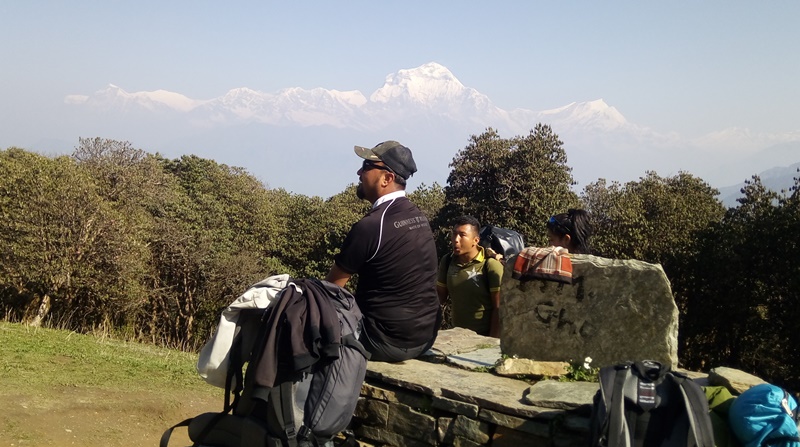
Note: The duration of each trek can vary depending on your pace and acclimatization breaks.
Yes, Mardi Himal Trek and Annapurna Base Camp (ABC) Trek can be great alternatives to the Poon Hill Trek.
Mardi Himal Trek is a relatively new and less crowded trek that offers stunning views of the Mardi Himal and Machhapuchhre (Fishtail) peaks. The trek takes you through rhododendron forests, traditional villages, and high-altitude pastures. The trail is challenging but offers a rewarding experience for trekkers.
Annapurna Base Camp Trek, on the other hand, is a classic trek that takes you to the base of the majestic Annapurna massif. The trek offers stunning views of the Annapurna and Dhaulagiri ranges and takes you through traditional villages, terraced fields, and lush forests.
Both Mardi Himal Trek and Annapurna Base Camp (ABC) Trek are longer and more challenging than the Poon Hill Trek, but they offer a more immersive and rewarding trekking experience. Make sure to consult with a licensed guide and porter before embarking on any trek in the region.
The Poon Hill region is rich in wildlife and flora/fauna, and trekking through the region offers a chance to encounter various species. Here are some of the notable wildlife and flora/fauna in the Poon Hill region:
Wildlife:
Flora/Fauna:
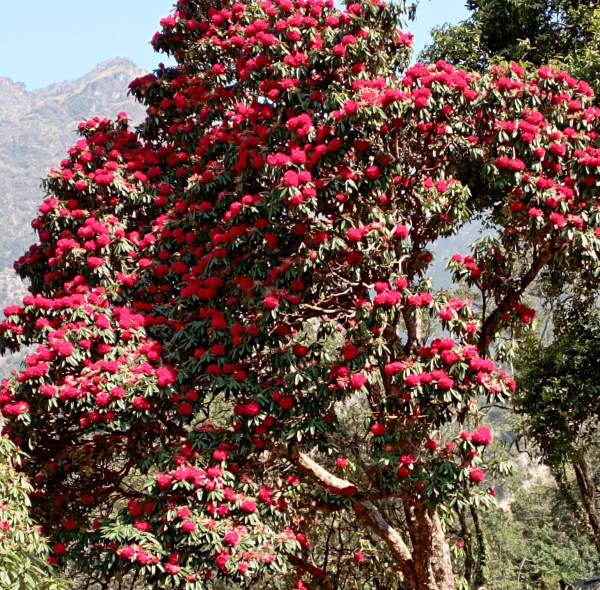
Blooming Rhododendron Flower around Ghoreapni poon hill area
It is essential to respect the natural habitats of these species and avoid disturbing them during your trek. As a responsible trekker, make sure to follow the Leave No Trace principles, such as packing out all trash and avoiding the use of single-use plastics.
The Poon Hill region is home to several ethnic communities, each with its unique traditions and customs. The region is predominantly inhabited by Gurung and Magar communities, who have a rich cultural heritage. Here are some of the local traditions and customs of the region:
As a responsible traveler, it is essential to respect the local traditions and customs of the region and engage with the locals in a culturally sensitive manner.
Eco-tourism plays a vital role in the Poon Hill region as it helps in preserving the natural environment and supporting the local communities. The region is known for its stunning landscapes, rich biodiversity, and unique cultural heritage. Here are some of the reasons why eco-tourism is essential in the Poon Hill region:
Overall, eco-tourism plays a crucial role in the sustainable development and preservation of the Poon Hill region, and trekkers can contribute to these efforts by engaging in responsible and sustainable tourism practices.
The Poon Hill trek is a moderate-level trek that requires a certain level of physical fitness and preparation. Here are some health and fitness requirements for the Poon Hill trek:
Cardiovascular Fitness: The Poon Hill trek involves a lot of uphill and downhill walking, which can be physically demanding. Good cardiovascular fitness is essential to handle the altitude and the steep terrain. Regular exercise such as hiking, jogging, cycling, or swimming can help improve your cardiovascular fitness.
Strength and Endurance: Trekking involves carrying a backpack with your essentials for several days. Therefore, it is crucial to have good strength and endurance to carry the load and hike for several hours a day. Strength training, such as weightlifting or bodyweight exercises, can help build your muscle strength, and endurance training, such as long walks or runs, can help build your stamina.
Altitude Acclimatization: The Poon Hill trek involves reaching high altitudes, which can cause altitude sickness. It is essential to acclimatize gradually to the altitude by taking enough rest and drinking plenty of water. Trekkers are advised to follow the recommended itinerary, which includes acclimatization days and gradual ascent to the higher altitudes.
Medical Check-up: Before embarking on the trek, it is recommended to have a medical check-up to ensure that you are physically fit to undertake the trek. Trekkers with pre-existing medical conditions should consult with their doctor and seek their advice.
It is essential to prepare well and maintain good physical fitness before undertaking the Poon Hill trek. By being physically prepared and following the recommended itinerary and guidelines, trekkers can have a safe and enjoyable trekking experience.
Deciding whether to trek Poon Hill solo or with a guide is a personal choice that depends on individual preferences, experience, and comfort level.
If you have experience trekking and feel confident in your abilities to navigate the trail, you may consider trekking Poon Hill solo. This can offer a sense of freedom and independence, allowing you to set your own pace and itinerary. However, it’s important to keep in mind that the Poon Hill trek can be challenging, and unexpected situations can arise, so it’s crucial to be prepared with proper gear, food, and water.
On the other hand, trekking with a guide can provide a safer and more comfortable experience, especially for those who are less experienced or unfamiliar with the trail. Guides are knowledgeable about the route and can offer valuable insights into local culture and customs. They can also help arrange transportation, accommodations, and meals, making the trip more hassle-free. Additionally, trekking with a guide can be a great way to support the local economy and provide income for local guides and their families.
Ultimately, whether to trek Poon Hill solo or with a guide depends on your personal preference and comfort level. If you’re unsure, it’s recommended to err on the side of caution and choose to trek with a guide for a safer and more enjoyable experience.
Safe Holiday Adventure Pvt. Ltd is a popular travel agency in Nepal that offers group tours and guided Poon Hill treks. They have experienced guides and staff who can provide a safe and enjoyable trekking experience.
You can book your group tour or guided Poon Hill trek with Safe Holiday Adventure Pvt. Ltd by visiting their website at www.safeholidayadventure.com or by contacting them through their email at info@safeholidayadventure.com. They offer various packages for different group sizes and trekking durations, and they can also customize their services to meet your specific needs and preferences.
When booking with Safe Holiday Adventure Pvt. Ltd, it is important to communicate your requirements clearly and ask any questions you may have beforehand to ensure a smooth and satisfactory experience.
The cost of the Poon Hill trek can vary depending on several factors, such as the duration of the trek, the number of people in your group, the season you choose to trek, and the services included in the package.
On average, the cost of a 4-6 day Poon Hill trek can range from $400 to $800 per person. This price typically includes permits, transportation, accommodation, meals, and the services of a licensed trekking guide.
However, it’s essential to note that this is just an estimated cost, and the actual cost may vary based on the factors mentioned above. It’s always best to check with a reputable trekking agency in Nepal, such as Safe Holiday Adventure Pvt. Ltd, to get an accurate and detailed cost breakdown for your specific trekking requirements.
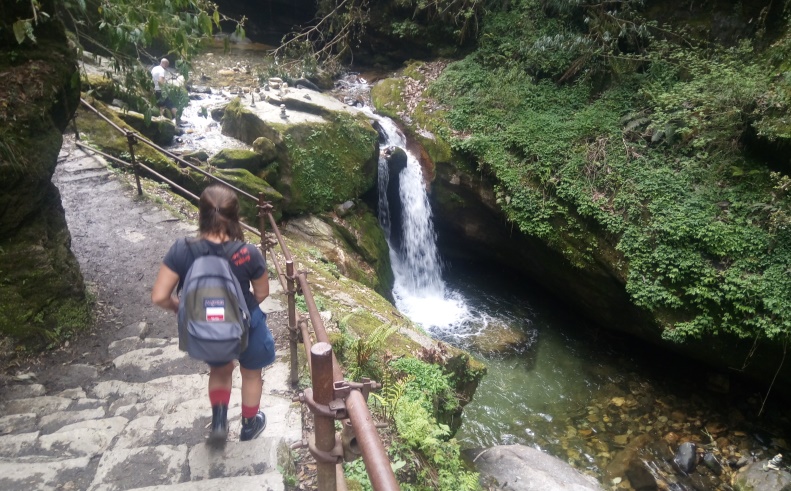
Waterfall before reaching Nangethati during Ghorepani trek
The Poon Hill trek is a popular trekking route in the Annapurna region of Nepal. It typically takes 5-7 days to complete, depending on your pace and itinerary. Here is a sample itinerary for the Poon Hill trek:
Day 1: Arrival in Kathmandu
Day 2: Fly to Pokhara (820m/2,690ft) and drive to Nayapul (1,070m/3,510ft) and trek to Tikhedhunga (1,480m/4,859ft) – 5-6 hours
Day 3: Trek to Ghorepani (2,750m/9,022ft) – 6-7 hours
Day 4: Hike to Poon Hill (3,210m/10,531ft) for sunrise view and trek to Tadapani (2,610m/8,563ft) – 6-7 hours
Day 5: Trek to Ghandruk (1,940m/6,364ft) – 3-4 hours
Day 6: Trek to Nayapul (1,070m/3,510ft) and drive to Pokhara – 4-5 hours
Day 7: Fly back to Kathmandu or spend an additional night in Pokhara
This itinerary is just a guide, and you can customize it to suit your preferences and time constraints. It’s essential to take enough time to acclimatize to the altitude and to allow for rest days to prevent altitude sickness. It’s also essential to choose a reputable trekking agency and a licensed guide to ensure your safety and enjoyment during the trek.
Safe Holiday Adventure Pvt. Ltd is a reputable local travel agency in Nepal that offers various trekking packages, including the Poon Hill trek. Here’s a sample 7-day Poon Hill trek package itinerary offered by Safe Holiday Adventure Pvt. Ltd:
Day 1: Arrival in Kathmandu
Day 2: Fly to Pokhara and drive to Nayapul and trek to Tikhedhunga
Day 3: Trek to Ghorepani
Day 4: Hike to Poon Hill for sunrise view and trek to Tadapani
Day 5: Trek to Ghandruk
Day 6: Trek to Nayapul and drive to Pokhara
Day 7: Fly back to Kathmandu or spend an additional night in Pokhara
This package includes the following services:
The cost of this package is USD 599 per person for a minimum of two people in a group. The price may vary depending on the number of people, season, and other factors. Safe Holiday Adventure Pvt. Ltd also offers customized packages based on your requirements and preferences.
It’s essential to choose a reputable and licensed trekking agency like Safe Holiday Adventure Pvt. Ltd to ensure your safety and enjoy a comfortable and hassle-free trekking experience.
The Poon Hill trek is a moderate trek in the Annapurna region of Nepal, and the distance covered each day may vary depending on your itinerary and pace. Here’s an approximate distance covered each day during the Poon Hill trek:
Day 1: Nayapul to Tikhedhunga – 11 kilometers (6.8 miles)
Day 2: Tikhedhunga to Ghorepani – 16 kilometers (9.9 miles)
Day 3: Ghorepani to Poon Hill (3,210m/10,531ft) and Tadapani – 13 kilometers (8.1 miles)
Day 4: Tadapani to Ghandruk – 9 kilometers (5.6 miles)
Day 5: Ghandruk to Nayapul – 5 kilometers (3.1 miles)
The total distance covered during the Poon Hill trek is approximately 54 kilometers (33.5 miles) over the course of 5 days. However, the actual distance may vary based on your itinerary and any detours or side trips you choose to take.
It’s essential to take the distance covered each day into consideration when planning your itinerary and ensure that you have enough time to rest and acclimatize to the altitude. It’s also important to pace yourself and avoid overexertion, especially during the steep uphill sections of the trek.
The Poon Hill trek in Nepal typically starts from Nayapul, which is a small town located about an hour’s drive from Pokhara. Nayapul is the gateway to the Annapurna region and is the starting point for many treks, including the Poon Hill trek.
The trek takes you through picturesque villages, terraced fields, and dense forests before culminating at the Poon Hill viewpoint. From there, you can enjoy stunning views of the Annapurna and Dhaulagiri mountain ranges.
After spending some time at Poon Hill, the trek usually retraces its path back to Nayapul, where it ends. Depending on the itinerary, the trek can last anywhere from 3 to 7 days, with varying levels of difficulty.